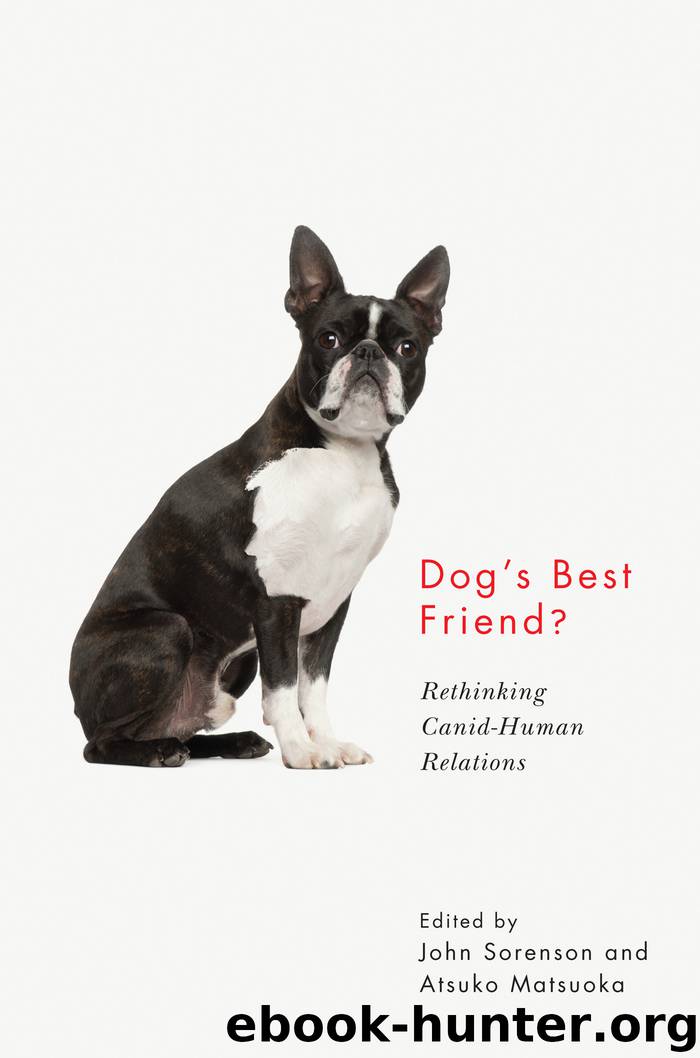Dog's Best Friend? by Unknown

Author:Unknown
Language: eng
Format: epub, mobi
Publisher: MQUP
Published: 2019-02-18T16:00:00+00:00
CHAPTER EIGHT
Gone Stray: A Journey of Gou Mama and Their Fur-Kids
Chia-ju Chang
Introduction1
In many big cities, free-roaming dogs – whether they are feral, semi-feral, stray, abandoned, or outdoor house pets – living on the streets in densely populated urban centres, either in separate colonies or in close contact with humans, are a fairly common sight.2 The existence of these dogs constitutes a contentious site between humans and nonhumans in Asian societies such as China, India, South Korea, and Vietnam, to name just a few. The issues involving street dogs vary from culture to culture, ranging from dog abandonment, theft and trafficking, illegal farming and trade, slaying (e.g., by trap or poison), to human and nonhuman interspecies tension, concerns for public safety and health, etc. The sustained stray dog problem in Taiwan results from a combination of the following forces: 1) the mass reproduction of dogs and their abandonment in the private puppy mill sector; 2) the lack of a consistently pursued spaying and neutering practice; 3) pet abandonment; and 4) the rapid procreation of stray dogs (Chien 2002). From the 1990s, the Taiwanese government began to adopt measures to control the stray dog population. In 1996, the government implemented a “garbage-does-not-touch-the-ground policy”; in 1999, the Legislative Yuan passed an animal protection law, adopting the US animal shelter policy of euthanasia. While the Taiwanese government continues to control the population growth of these dogs by way of systematic extermination, instead of adopting other means of control such as TNVR (trapping, neutering, vaccinating, and releasing) or more innovative means such as building “dog condos” as in Thailand, their effort, however great, has not been effective (Jennings 2007).
To protest the government’s ineffective way of handling the stray issue, several voices have emerged to intervene. These include the growing population of pet lovers, writers, and animal protection groups. Animal protection organizations such as the ROC Animal Protection Association (Taiwan dongwu baohu xiehui), Environment & Animal Society of Taiwan (EAST; Taiwan dongwu shenhui yanjiushe), and Life Conservationist Association (Shengming guanhuai xiehui), to name but a few, have been campaigning to reform inhumane animal control practices, to improve animal shelters, to promote responsible pet ownership, and to draw up and implement animal protection legislation. Celebrities and writers have turned their gaze upon this group of animals; they not only write about stray dogs and cats, but also organize press conferences to help raise awareness. Among these stray animal advocacy groups, the most low-profiled and marginalized (both silent and silenced) are the so-called “dog mothers” (gou mama in Mandarin). The term is used to describe these “caretakers” who are on the frontline of stray dog carework.
To date, substantial critical attention in the West has been devoted to dogs in the categories of pets or companion animals, dogs in animal shelters, training dogs, and dogs performing other conventional canine roles (so-called “dogological studies,” a term invented by Elizabeth Marshall Thomas), but little attention has been paid to abandoned or free-roaming dogs in the street,3 nor to “stray studies.” The
Download
This site does not store any files on its server. We only index and link to content provided by other sites. Please contact the content providers to delete copyright contents if any and email us, we'll remove relevant links or contents immediately.
Adulting by Kelly Williams Brown(3671)
Figure Drawing for Artists by Steve Huston(2799)
Draw Your Day by Samantha Dion Baker(2708)
Drawing Cutting Edge Anatomy by Christopher Hart(2678)
Drawing Shortcuts: Developing Quick Drawing Skills Using Today's Technology by Leggitt Jim(2532)
Make Comics Like the Pros by Greg Pak(2423)
Draw to Win: A Crash Course on How to Lead, Sell, and Innovate With Your Visual Mind by Dan Roam(2277)
How Proust Can Change Your Life by Alain De Botton(2261)
Day by Elie Wiesel(2243)
0041152001443424520 .pdf by Unknown(2220)
How The Mind Works by Steven Pinker(2214)
Rapid Viz: A New Method for the Rapid Visualization of Ideas by Kurt Hanks & Larry Belliston(2195)
Modern Cartooning by Christopher Hart(2189)
Poses for Artists Volume 2 - Standing Poses: An essential reference for figure drawing and the human form. (Inspiring Art and Artists) by Justin Martin(2145)
Draw-A-Saurus by James Silvani(2105)
Learn Drawing Quickly by Sharon Finmark(2090)
Tattoo Art by Doralba Picerno(2083)
Poses for Artists - Dynamic & Sitting: An essential reference for figure drawing and the human form (Inspiring Art and Artists Book 1) by Justin R Martin(2063)
Drawing and Painting Birds by Tim Wootton(2001)
